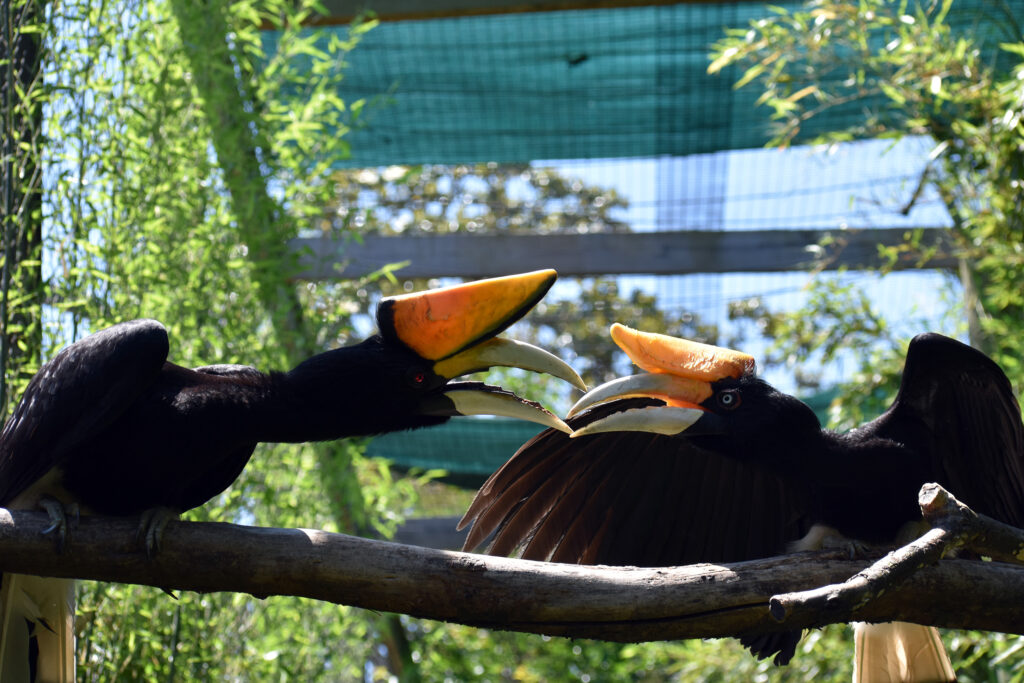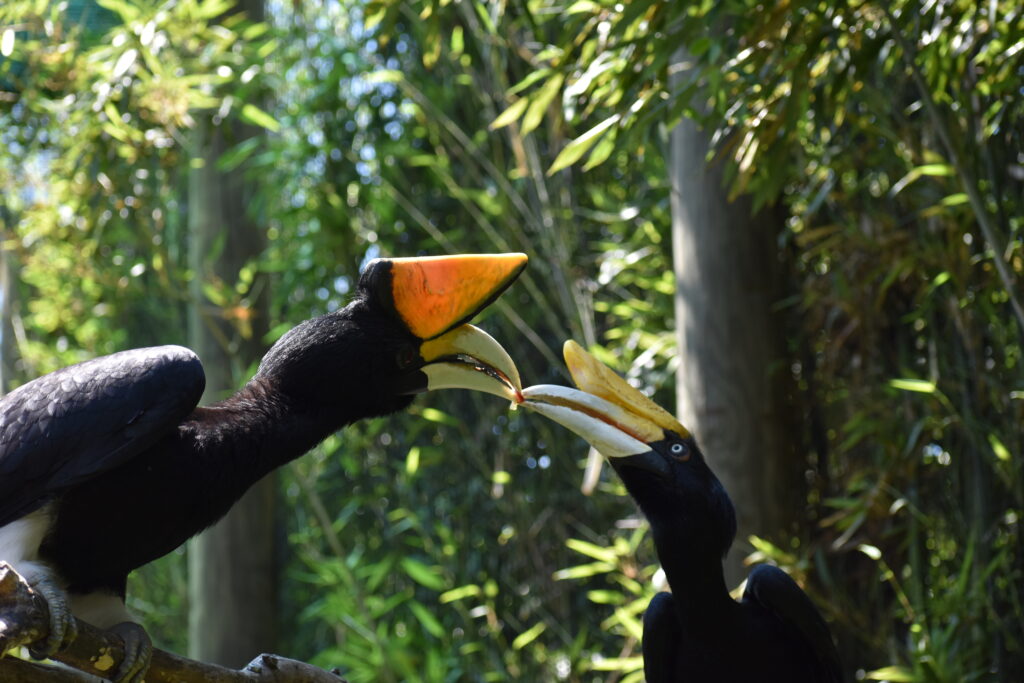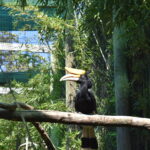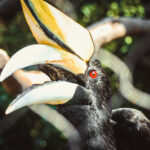Hooked on Hornbills
The rhinoceros hornbill. No, it’s not the mammal you are familiar with, but instead another kind of gentle giant and one that is rarely seen in the wild. Once you do lay eyes upon them, you’ll see exactly why the species has its name.
A rhino hornbill is covered in jet black feathers and has a white tail with a single black stripe. The most striking feature isn’t their feathers, but what’s protruding from their face. On top of the white beak is a beautifully colored yellowish-orange casque, which is a helmet-like structure that aids in amplifying the bird’s calls. The horn is naturally creamy-white but becomes yellowish-orange from the bird rubbing it against a gland under the its tail. The species earned its name from this predominant facial feature and the casque is actually made of keratin, just like in human hair and fingernails! 
This species of hornbill is one of the largest in Asia, growing to be up to 50 inches in height and weighing up to six pounds. Males and females are sexually dimorphic, meaning they have a feature to tell the different sexes apart. For rhino hornbills, you can tell males and females apart by looking at their eyes – males will have a black-rimmed red eye, while females have a red-rimmed white eye.
Courtship for these birds is serious business. They mate for life and often have bonding rituals that consist of sharing food. Once the pair breed, they will pick a hollow tree to build a nest. Once the setting is just right, the male will help seal the female inside of the nest by using food, mud and bird droppings, leaving only a small slit that will be used by the the male to feed his mate and, if successful, their chicks.

For 50 days, the female is encapsulated in the nest, incubating one to two eggs until they hatch. Once hatched, she breaks out of the cavity and reseals the nest, keeping the chicks safely inside. For the next three months, the parents feed the chicks through the tiny slit until they are old enough to break out of the nest on their own and fly the coop.
Food for rhino hornbills consists of fruits, nuts, some insects and small animals including lizards and smaller birds. They are native to dense rainforests in Brunei Darussalam, Indonesia, Malaysia, and Thailand. They are primarily arboreal and spend their entire lives in trees, never going down to the ground.
Rhino hornbills are listed as vulnerable to extinction by the International Union for Conservation of Nature’s Red List. Threats to this species include forest destruction in the Sundaic lowlands of Indonesia that have been extensive as a result of commercial and illegal logging, as well as agricultural development. The Virginia Zoo contributes annually to several conservation projects that aim to prevent this species, and other hornbill species, from going extinct.
 At the Virginia Zoo, there are two rhino hornbills. Oona, our female hornbill is 12 years old and was born at the Phoenix Zoo. She enjoys eating grapes, blueberries and a special Mazuri Softbill gel, which resembles white jello (unless Chef Yohn adds some fun color to it), but is a yummy treat formulated with the species’ specific vitamins and nutrients. Oona can often be seen out on exhibit hopping on branches, but if you can’t spot her, it’s probably because she is inside away from her exhibit mate for some preferred alone time. Girls just wanna have fun, but they want their peace and quiet too!
At the Virginia Zoo, there are two rhino hornbills. Oona, our female hornbill is 12 years old and was born at the Phoenix Zoo. She enjoys eating grapes, blueberries and a special Mazuri Softbill gel, which resembles white jello (unless Chef Yohn adds some fun color to it), but is a yummy treat formulated with the species’ specific vitamins and nutrients. Oona can often be seen out on exhibit hopping on branches, but if you can’t spot her, it’s probably because she is inside away from her exhibit mate for some preferred alone time. Girls just wanna have fun, but they want their peace and quiet too!
 Riobi, our male, is 12 years old and was born at the Houston Zoo but has been at the Virginia Zoo since 2010. He enjoys eating grapes and any sweet fruit – the sweeter the better! Keepers say Riobi likes to train before Oona so he can steal all of the grapes, then he often regurgitates them, throws them into the air and re-eats them – the audacity! Keepers also say Riobi likes to show-off as a way to flirt with Oona.
Riobi, our male, is 12 years old and was born at the Houston Zoo but has been at the Virginia Zoo since 2010. He enjoys eating grapes and any sweet fruit – the sweeter the better! Keepers say Riobi likes to train before Oona so he can steal all of the grapes, then he often regurgitates them, throws them into the air and re-eats them – the audacity! Keepers also say Riobi likes to show-off as a way to flirt with Oona.
Rhino hornbills are highly intelligent and Keepers must ensure the pair is kept busy with a wide variety of enrichment. Oona loves logs that she can rub her beak on or items she can open with her beak, while Riobi loves puzzle feeders. Both birds prefer enrichment items that requires them to use their beaks.
As long as the weather is warm enough, the pair are on exhibit in their very own aviary along the Asia – Trail of the Tiger. Be sure to stop by to see them on your next visit to the Zoo, You can also donate to help their wild counterparts – by making change and playing our Quarters for Conservation Kiosk in the Zoo’s Plaza.